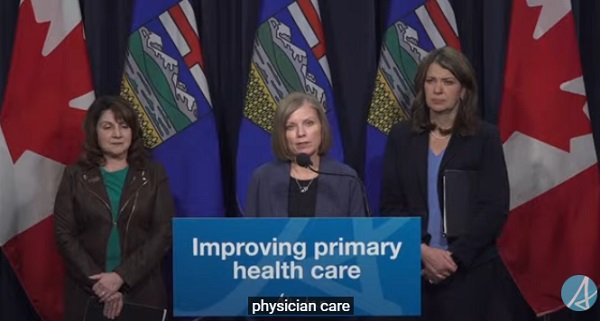Alberta
Province says Alberta family doctors will be the best-paid and most patient-focused in the country

Dr. Shelley Duggan, president, Alberta Medical Association
New pay model, better access to family doctors |
Alberta’s government is implementing a new primary care physician compensation model to improve access to family physicians across the province.
Alberta’s government recognizes that family physicians are fundamental to strengthening the health care system. Unfortunately, too many Albertans do not currently have access to regular primary care from a family physician. This is why, last year, the government entered into a memorandum of understanding with the Alberta Medical Association (AMA) and committed to developing a new primary care physician compensation model.
Alberta’s government will now be implementing a new compensation model for family doctors to ensure they continue practising in the province and to attract more doctors to choose Alberta, which will also alleviate pressures in other areas of the health care system.
This new model will make Alberta’s family doctors the strongest-paid and most patient-focused in the country.
“Albertans must be able to access a primary care provider. We’ve been working hard with our partners at the Alberta Medical Association to develop a compensation model that will not only support Alberta’s doctors but also improve Albertans’ access to physicians. Ultimately, our deal will make Alberta an even more attractive place to practise family medicine.”
“We have worked with the Alberta Medical Association to address the challenges that primary care physicians are facing. This model will provide the supports physicians need and improve patient access to the care they need.”
The new model is structured to encourage physicians to grow the number of patients they care for and encourage full-time practice. Incentives include increases for:
- Maintaining high panel numbers (minimum of 500 patients), which will incentivize panel growth and improve access to primary care for patients.
- Providing after-hours care to relieve pressure on emergency departments and urgent care centres.
- Improving technology to encourage using tools that help streamline work and enhance patient care.
- Enhancing team-based care, which will encourage developing integrated teams that may include family physicians, nurse practitioners, registered nurses, dietitians and pharmacists to provide patients with the best care possible.
- Adding efficiencies in clinical operations to simplify processes for both patients and health care providers.
As a market and evidence-based model, it recognizes and pays for the critically important work of physicians, including the number of patients seen and patient complexity, as well as time spent providing direct and indirect care.
“Family medicine is the foundation of our health care system. This model recognizes the extensive training, experience and leadership of primary care physicians, and we hope it will help Alberta to attract and retain more family medicine specialists who provide comprehensive care.”
Additionally, family physicians who are not compensated through the traditional fee-for-service model will now receive higher pay rates under their payment model, known as the alternative relationship plan. This includes those who provide inpatient care in hospitals and rural generalists. Alberta’s government is increasing this to ensure hospital-based family physicians and rural generalists also receive fair, competitive pay that reflects the importance of these roles.
“This new compensation model will make Alberta more attractive for physicians and will make sure more Albertans can have improved access to a primary care provider no matter where they live. It will also help support efforts to strengthen primary care in Alberta as the foundation of the health care system.”
“Family physicians have been anxiously awaiting this announcement about the new compensation model. We anticipate this model will allow many primary care physicians to continue to deliver comprehensive, lifelong care to their patients while keeping their community clinics viable.”
Quick facts
- Enrolment in the primary care physician compensation model will begin in January with full implementation in spring 2025, provided there are at least 500 physicians enrolled.
- The alternative relationship plan rate has not been updated since it was initially calculated in 2002.
- The new compensation model for family doctors is the latest primary health care improvement following actions that include:
- A $42-million investment to recruit more health providers and expand essential services.
- A new rural and remote bursary program for family medicine resident physicians.
- Additional funding of $257 million to stabilize primary care delivery and improve access to family physicians.
- Implementing the Nurse Practitioner Primary Care Program, which expands the role of nurse practitioners by allowing them to practise comprehensive patient care autonomously, either by operating their own practices or working independently within existing primary care settings.
Related information
Alberta
Made in Alberta! Province makes it easier to support local products with Buy Local program

Show your Alberta side. Buy Local. |
When the going gets tough, Albertans stick together. That’s why Alberta’s government is launching a new campaign to benefit hard-working Albertans.
Global uncertainty is threatening the livelihoods of hard-working Alberta farmers, ranchers, processors and their families. The ‘Buy Local’ campaign, recently launched by Alberta’s government, encourages consumers to eat, drink and buy local to show our unified support for the province’s agriculture and food industry.
The government’s ‘Buy Local’ campaign encourages consumers to buy products from Alberta’s hard-working farmers, ranchers and food processors that produce safe, nutritious food for Albertans, Canadians and the world.
“It’s time to let these hard-working Albertans know we have their back. Now, more than ever, we need to shop local and buy made-in-Alberta products. The next time you are grocery shopping or go out for dinner or a drink with your friends or family, support local to demonstrate your Alberta pride. We are pleased tariffs don’t impact the ag industry right now and will keep advocating for our ag industry.”
Alberta’s government supports consumer choice. We are providing tools to help folks easily identify Alberta- and Canadian-made foods and products. Choosing local products keeps Albertans’ hard-earned dollars in our province. Whether it is farm-fresh vegetables, potatoes, honey, craft beer, frozen food or our world-renowned beef, Alberta has an abundance of fresh foods produced right on our doorstep.
Quick facts
- This summer, Albertans can support local at more than 150 farmers’ markets across the province and meet the folks who make, bake and grow our food.
- In March 2023, the Alberta government launched the ‘Made in Alberta’ voluntary food and beverage labelling program to support local agriculture and food sectors.
- Through direct connections with processors, the program has created the momentum to continue expanding consumer awareness about the ‘Made in Alberta’ label to help shoppers quickly identify foods and beverages produced in our province.
- Made in Alberta product catalogue website
Related information
Alberta
Province to expand services provided by Alberta Sheriffs: New policing option for municipalities

Expanding municipal police service options |
Proposed amendments would help ensure Alberta’s evolving public safety needs are met while also giving municipalities more options for local policing.
As first announced with the introduction of the Public Safety Statutes Amendment Act, 2024, Alberta’s government is considering creating a new independent agency police service to assume the police-like duties currently performed by Alberta Sheriffs. If passed, Bill 49 would lay additional groundwork for the new police service.
Proposed amendments to the Police Act recognize the unique challenges faced by different communities and seek to empower local governments to adopt strategies that effectively respond to their specific safety concerns, enhancing overall public safety across the province.
If passed, Bill 49 would specify that the new agency would be a Crown corporation with an independent board of directors to oversee its day-to-day operations. The new agency would be operationally independent from the government, consistent with all police services in Alberta. Unlike the Alberta Sheriffs, officers in the new police service would be directly employed by the police service rather than by the government.
“With this bill, we are taking the necessary steps to address the unique public safety concerns in communities across Alberta. As we work towards creating an independent agency police service, we are providing an essential component of Alberta’s police framework for years to come. Our aim is for the new agency is to ensure that Albertans are safe in their communities and receive the best possible service when they need it most.”
Additional amendments would allow municipalities to select the new agency as their local police service once it becomes fully operational and the necessary standards, capacity and frameworks are in place. Alberta’s government is committed to ensuring the new agency works collaboratively with all police services to meet the province’s evolving public safety needs and improve law enforcement response times, particularly in rural communities. While the RCMP would remain the official provincial police service, municipalities would have a new option for their local policing needs.
Once established, the agency would strengthen Alberta’s existing policing model and complement the province’s current police services, which include the RCMP, Indigenous police services and municipal police. It would help fill gaps and ensure law enforcement resources are deployed efficiently across the province.
Related information
-

 Business1 day ago
Business1 day agoChina, Mexico, Canada Flagged in $1.4 Billion Fentanyl Trade by U.S. Financial Watchdog
-

 2025 Federal Election2 days ago
2025 Federal Election2 days agoTucker Carlson Interviews Maxime Bernier: Trump’s Tariffs, Mass Immigration, and the Oncoming Canadian Revolution
-

 espionage2 days ago
espionage2 days agoEx-NYPD Cop Jailed in Beijing’s Transnational Repatriation Plot, Canada Remains Soft Target
-

 Business2 days ago
Business2 days agoDOGE Is Ending The ‘Eternal Life’ Of Government
-

 2025 Federal Election1 day ago
2025 Federal Election1 day agoBREAKING from THE BUREAU: Pro-Beijing Group That Pushed Erin O’Toole’s Exit Warns Chinese Canadians to “Vote Carefully”
-

 2025 Federal Election2 days ago
2025 Federal Election2 days agoCanada drops retaliatory tariffs on automakers, pauses other tariffs
-

 Daily Caller1 day ago
Daily Caller1 day agoDOJ Releases Dossier Of Deported Maryland Man’s Alleged MS-13 Gang Ties
-

 Daily Caller1 day ago
Daily Caller1 day agoTrump Executive Orders ensure ‘Beautiful Clean’ Affordable Coal will continue to bolster US energy grid




